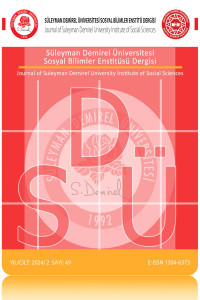Öz
Sagalassos antik kenti gerek mevcut kalıntıları gerekse teritoryumunun büyüklüğü göz önüne alındığında oldukça geniş bir yelpazede buluntu ve bilgi sunan önemli bir Pisidia kentidir. Bu makalede ise Ağlasun’da saptanan ve Sagalassos kazıevi deposunda yer alan tek bir mezar sunağı tipolojik, ikonografik, epigrafik ve bezeme unsurları açısından derinlemesine ele alınacaktır. Buluntu yeri Burdur İli Ağlasun İlçesi olan mezar sunağı, dörtgen formda olup yerel kireç taşından yapılmıştır. Farklı formda ve çeşitli figür ve bezeme unsurları ile süslü mezar sunaklarının nekropolis alanlarında ölü kültü çerçevesinde üzerinde libasyon yapmak ve ölenlerin kimliklerini tanıtılması bakımından mezar işaretleyicisi olarak kullanıldığı bilinmektedir. İncelediğimiz eserde benzer bir işleve sahiptir. Mezar sunağı gövde üzerinde yer alan kabartmalar phiale, parşömen ve yazıt kapsamında ikonografik olarak yorumlanmıştır. Yazıttan elde edilen bilgilere göre sunak bir aile adına yaptırılmıştır. Ön yüzde ve sağ yüzde aile fertlerinin ismi yazmaktadır. Dolayısıyla üzerinde betimlenen figürler aile bireylerini temsil etmektedir. Açık parşömen rulosu eğitime işaret ederken, phiale ritüel açıdan libasyon amacına yönelik olarak kullanılan bir kap niteliğindedir. Eser üzerindeki tipolojik, stilistik ve ikonografik değerlendirmelerimiz ve aynı zamanda benzer örneklerden hareketle incelediğimiz sunağın MS 3. yüzyıl özelliklerini taşıdığı anlaşılmaktadır.
ABSTRACT
Considering its size and ruins, Sagalassos is an important Pisidian city that has yielded a great number of finds, providing information on a wide range of topics, including funerary practices. In this article, a funerary altar found in Ağlasun (Ağlasun District of Burdur Province) and stored in the depots of the Sagalassos excavation house will be discussed in terms of its typological, iconographic, epigraphic and decorative elements. The grave altar is rectangular in form and made of local limestone. It is known that grave altars of different forms and featuring various figures and decoration elements were used as grave markers in the necropolis for libations and identification of the dead within the framework of the cult of the dead. The object examined in this paper had a similar function. The reliefs present on the shaft of the altar have been interpreted iconographically in the light of the present inscriptions. According to the information obtained from the inscription, the altar was built on behalf of a family. The names of family members are written on the front and right side. Therefore, the figures depicted on the same side can most probably be identified as the mentioned family members. While the open parchment roll indicates education, the depicted phiale is a vessel typically used for ritual libations. Based on our typological, stylistic and iconographic evaluations on the object, as well as the inscription, the altar can be dated to the 3rd century AD.
Keywords: Sagalassos, Pisidia, Funerary Altar, Roman Imperial Period.
Anahtar Kelimeler
Kaynakça
- Abay, N., (2020). Konya Ereğli Müzesi’nden Bir Zeus Sunağı. TÜBA-KED 21, 199-208.
- Akçay, T. (2017). Yunan ve Roma’da Ölü Kültü. Bilgin Kültür ve Sanat Yayınları.
- Amico, L. N. (1988). Bust of the Young Marcus Aurelius. The J. Paul Getty Museum Journal 16, 95-104.
- Aydınoğlu, Ü. (2013). Paslı: Dağlık Kilikia’da bir Kırsal Yerleşimin Değişim Süreci. Olba 21, 71-100.
- Aytekin, F. (2017). Stratonikeia Kökenli Kabartmalı Mezar Stelleri. (Yayınlanmamış Yüksek Lisans Tezi). Pamukkale Üniversitesi Arkeoloji Ensitütüsü, Denizli.
- Diler, N. K. (1996). Anadolu Girlandlı Sunakları. (Yayınlanmamış Doktora Tezi). Atatürk Üniversitesi, Sosyal Bilimler Enstitüsü, Arkeoloji ve Sanat Tarihi Anabilim Dalı, Erzurum.
- Gürer, A. (2006). Örneklerle Sunak Tipolojisi. (Yayınlanmamış Yüksek Lisans Tezi). Dokuz Eylül Üniversitesi, Sosyal Bilimler Enstitüsü, Arkeoloji Anabilim Dalı,İzmir.
- Horsley, G. H. R. (2007). The Greek and Latin Inscription In The Burdur Archaeological Museum. Regional Epigraphic Catalogues of Asia Minor V. The British Institute at Ankara Monographs, 34.
- Köse, V. (2005). Die Nekropolen und Grabdenkmäler von Sagalassos in Pisidian in hellenistischer und römischer Zeit. Studies in Eastern Mediterranean Archaeology VII.
- Küçükcan, M. (2019). Akmonia Antik Kenti Mezar Stelleri ve Bomoslar. (Yayınlanmamış Yüksek Lisans Tezi). Uşak Üniversitesi Sosyal Bilimler Enstitüsü.
- Mitchell, S. (1999). Greek Epigraphy and Social Change, A Study of Romanization of South-West Asia Minor in the Third Century A.D.XI.Congresso Internazionale di epigraphia greca e latina, Roma 18-24 settembre 1997, 419-433.
- Mörel, A. (2014). Dağlık Kilikia Bölgesinde (Olba Territoriumu) Özköy Antik Yerleşimi: Tarımsal Organizasyon ve Yerleşim düzenlemesi. D.B. Erciyas - E. Sökmen (Eds.), Arkeoloji’de Bölgesel Çalışmalar 4-1, Sempozyum Bildirileri / Regional Studies in Archaeology Symposium Proceedings Ankara,12-13 Mayıs 2011, İstanbul, 147-171.
- Özgan, R. (2013). Roma Portre Sanatı II. Ege Yayınları. Tanrıver, Ö. (2016). Antik Kaynaklar, Epigrafik ve Arkeolojik Veriler Işığında Kuzeybatı Pisidia’nın Kültürel Kimliği. (Yayınlanmamış Yüksek Lisans Tezi). Süleyman Demirel Üniversitesi Sosyal Bilimler Enstitüsü, Isparta.
- Waelkens, M. (1993). Sagalassos, History and Archaeology. M. Waelkens (Ed.) Sagalassos I. First General Report on the Survey (1986-1989) and Excavations (1990-1991), 37-81.
- Waelkens, M. Sagalassos Antik Kenti Burdur’da Bir Tarih Kesiti, (Ed.) M. Zeki Yıldırım, Şevkiye Kazan Nas ve Gökay Yıldız. I. Burdur Sempozyumu: Bildiriler, 16-19 Kasım 2005, Cilt 1-2, s. 688-695.
- Waelkens, M. - Poblome, J. (2012). Sagalassos, City of Dreams. M. Waelkens - J. Poblome (Eds.). Openbaar Kunstbezit Vlaanderen.
- Yavis, C. G. (1949). Greek Altars, Origins and Typology, including the Minoan-Mycenaean offertory. St. Louis University Press.
Ayrıntılar
| Birincil Dil | Türkçe |
|---|---|
| Konular | Arkeoloji Bilimi |
| Bölüm | Makaleler |
| Yazarlar | |
| Yayımlanma Tarihi | 31 Ağustos 2024 |
| Gönderilme Tarihi | 6 Nisan 2024 |
| Kabul Tarihi | 25 Haziran 2024 |
| Yayımlandığı Sayı | Yıl 2024 Sayı: 49 |
.


